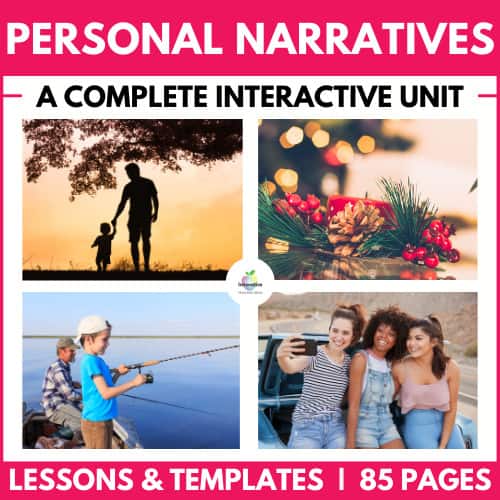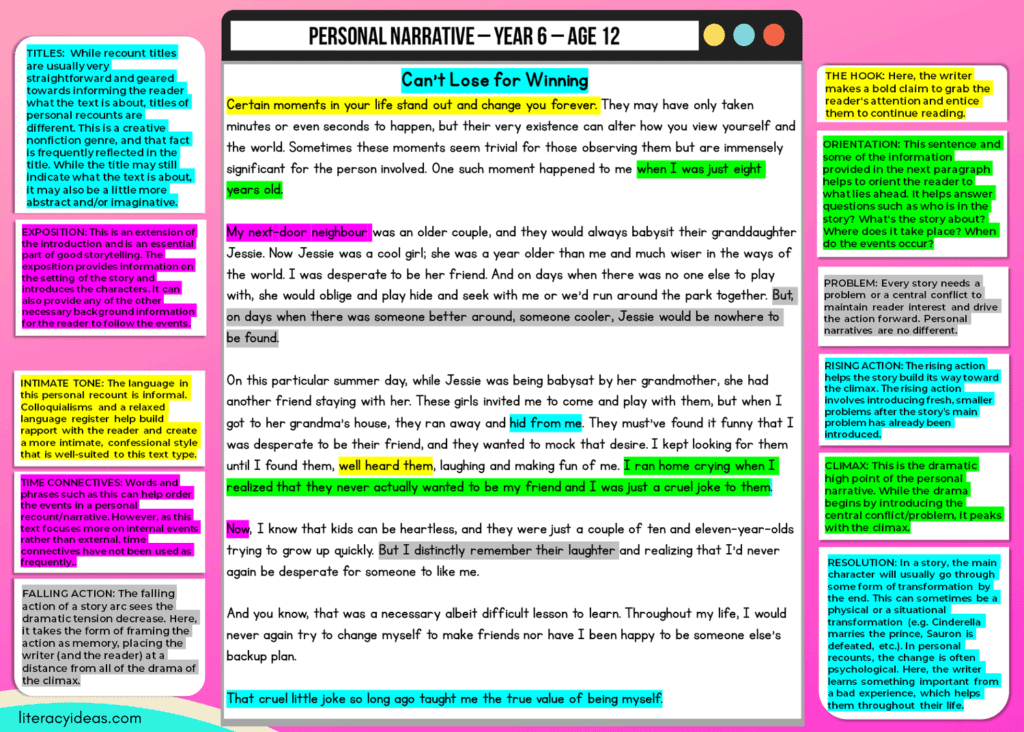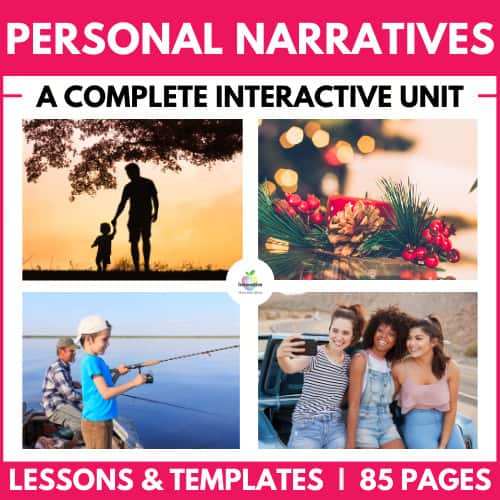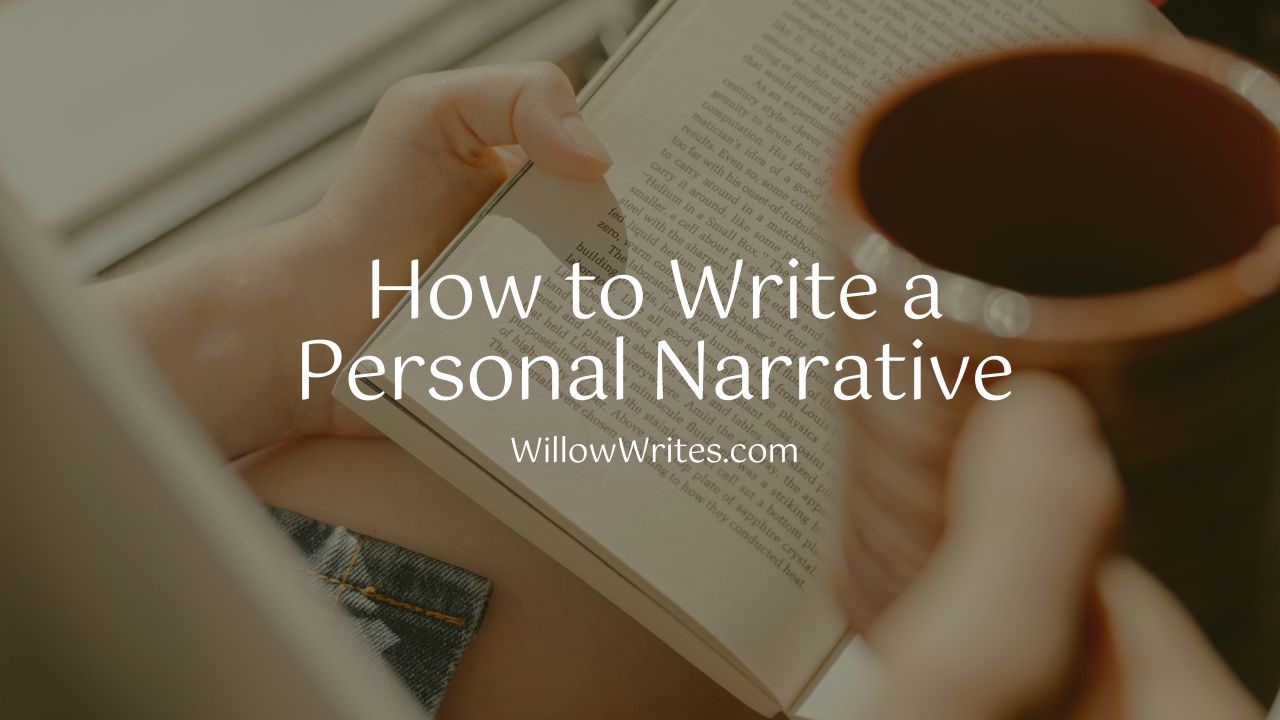Narrative Essay Writing
Personal Narrative Essay


Personal Narrative Essay - Easy Guide & Examples
16 min read
Published on: Apr 18, 2020
Last updated on: Mar 24, 2024

People also read
How to Write a Narrative Essay in Simple Steps
Interesting Narrative Essay Topics and Ideas
20+ Top Narrative Essay Examples by Experts
Share this article
A personal narrative essay can be a fun way to share your life story with friends and family. However, most students have no idea how to write a personal narrative essay.
This can be a challenge. On top of that, it's one of the most common assignments in school.
Is this something that you are also dealing with? Fortunately, you don't have to worry anymore! We are here to simplify the process for you.
This guide will walk you through the process of writing a personal narrative essay step by step. Plus, you can find plenty of examples here to help you get started and avoid common writing mistakes.
So what are you waiting for, take a step forward to make your essay shine!
On This Page On This Page -->
Personal Narrative Essay Definition
What is a Personal Narrative Essay?
A personal narrative essay is also referred to as short storytelling. It depends on the writer's type of story they want to tell the readers. This type of essay can be composed of the personal experience of the writer.
A personal narrative essay is usually written in the first person participle. It helps to depict a clear narrative thatâs focused on a specific moment.
Usually, high school students are usually assigned to write such essays. Writing these essays helps them to enhance creative writing skills. Also, they help to provide insight into a studentâs personal life.
To write a personal narrative essay, the writer specifies a plot around which the entire essay revolves. Moreover, the plot should also discuss the characters that have played some part in the story.
Sample Personal Narrative Essay (PDF)
How to Start a Personal Narrative Essay?
The personal narrative essay requires a balance between objectivity and subjectivity. To write about an event or situation with significance, you must first identify what's important to share with the readers.
As with other types of writing - there are some guidelines you need to follow some guidelines. These are;
1. Choose the Right Topic
A good topic can not just make your essay look good, but also it will make the writing process much easier. Since personal narrative essays are written on personal experiences and thoughts, make sure you choose your most interesting experience.
Keep in mind that the topic you choose matches the intended audience. It is the reader who decides the scope and success of your essay.
2. Choose a Theme
You can also choose a theme for your essay. This will help you focus on what you want to say. You can use your personal experiences to explore the theme in depth. For example, if you choose the theme of love, you could talk about your experience of love with your sister(s). Alternatively, you can start writing out the story and see if any ideas might relate to a bigger theme. When you are writing, pay attention to any ideas that keep coming up. See if they might be related to a bigger topic.
3. Create a Thesis Statement
The thesis statement is the most important sentence and tells the reader what your essay will be about.
In a personal narrative essay, the thesis statement can briefly explore the story's events. Or it can tell the reader about the moral or lesson learned through personal experience. The thesis statement can also present the main theme of the essay.
For example, if you are writing an essay about your personal experience as a refugee. You may have a thesis statement that presents the theme of freedom.
Check out more thesis statement examples to learn how to write one!
4. Create an Outline
Once you have your topic, it is time that you create an outline for your essay. The essay outline is an essential element of an essay. It keeps the whole composition in an organized order.
Also, it helps the reader through the essay. With the help of an outline, a writer can provide logic for the essay.
Personal Narrative Essay Outline
Being a student, you must know how important an outline is for an essay. It provides an organization with the whole content.
To create an outline for a personal narrative essay, you need to follow the following traditional method.
Introduction
These three major elements of a narrative essay are further elaborated down below.
The introduction is the most important part of essay writing. It is the first impression on the reader; by reading this part, the reader decides the quality of the essay. This part should be the most attention-grabbing part.
It should have an attention-grabbing hook and some background information about the topic. Moreover, it should include the thesis statement, which explains the main idea of your essay.
Keep in mind that the essay introduction should always end with a transition sentence. This will make a logical connection with the rest of the essay.
Personal Narrative Introduction Example
Body Paragraphs
After the introduction, the body paragraphs are written. These paragraphs help you to explain the key elements of your personal narrative essay.
In a standard personal narrative essay, there are usually three body paragraphs. These paragraphs help the writer to describe the subject of the essay in all possible aspects.
With the help of these paragraphs, the writer describes their point of view to the readers. To support the essay, the time and place of the event happening are also mentioned. Moreover, these paragraphs have all the information about the characters.
Keep in mind that a body starts with a topic sentence . This sentence is a kind of introductory sentence for that particular paragraph.
Another important thing you need to keep in mind is the order in which you will present the details. Make sure that you use chronological order for this purpose.
Personal Narrative Body Example
In conclusion, you need to provide the climax of the story.
In this section of a personal narrative essay, you should wrap up the whole story. Do it in such a way that you provide a summary of the entire essay.
Your conclusion should be just as impactful as your introduction. End with a memorable sentence or thought that leaves the reader with a lasting impression. You can summarize the main points of your essay or reflect on the significance of the experience in your life.
Make sure that you do not add any new points in this part. It will not give the reader a sense of accomplishment and will leave them in confusion.
Personal Narrative Conclusion Example
How to Write a Personal Narrative Essay
A personal narrative essay is considered very good when it is expressive, and the reader enjoys your personal narrative. The key to writing an amazing personal narrative is to use sensory details as much as possible.
An excellent narrative essay doesn't tell what happened. Instead, it shows what happened precisely and how you have felt at that moment.
Here is how you can write a personal narrative essay:
- Start With a Good Hook
For any type of essay , a hook statement can be a game-changer. But, particularly for a personal narrative essay, hook sentences are very important.
Usually, the introduction of the essay starts with this sentence. You may use a famous quotation, verse, or an interesting fact for this purpose. This sentence helps to attain the readerâs attention and persuade the reader to read the entire essay.
- Vivid Description
For a narrative essay, it is a must to be vivid enough to let the reader imagine the whole scene. This is why it is necessary that the writer uses as much descriptive language as possible.
For instance, if you are writing about a visit to the beach, you can describe how the sun felt on your face. On top of that, making use of strong verbs and adjectives will also help to provide an engaging experience for readers.
- Use Transition Words
For any essay, be it an argumentative essay , descriptive essay , or personal narrative essay. It is very important to have some transition sentences and words. These transition words help to make a logical connection in all parts of the essay.
In other words, the transition words help to make links between the storyline. You may use transition words like this, however, whereas, therefore, moreover, etc.
- Add Emotions
The purpose of a personal narrative essay is to show the reader what and how you have felt. Hence don't forget to add the emotions, as you have to make the reader know about the feelings.
Describe all of the emotions and feelings using very descriptive words.
- Be Consistent
Consistency is the key to writing an essay in a professional way. Make sure that you don't get distracted by any irrelevant details.
Stay focused on one single point, and add details related to your specific idea. Make sure that you inter-link all the events of the story in a regular manner. This will help the reader to relate all the events. Also, use first-person impressions as you are writing a personal narrative.
You also want to show the reader that you are telling your own story. Make sure that you follow the same participle in the entire essay.
- Prove the Significance of Your Experience
You know that behind every event, there is a reason. Similarly, let your readers know the reason behind your essay and its significance.
Also, mention that the story you just told was important to share.
As it is a personal narrative, you don't have to provide evidence to prove the significance of your story. Rather, you have to convey a broader message through your story.
- Use Dialogue
Dialogue is an excellent way to bring life to your story and make it more engaging. It can reveal the characterâs personalities and add a touch of realism to the essay.
When you use dialogue, make sure to punctuate it correctly and indicate who is speaking.
- Show, Don't Tell
When writing a personal narrative essay, avoid summarizing events and simply telling the story. Instead, use sensory details to help the reader experience the story with you.
Describe what you saw, heard, felt, tasted, and smelled to bring the story to life.
- Reflect on the Experience
Reflection is an important part of any personal narrative essay. It is an opportunity for you to reflect on the experience you are writing about and what it means to you. Take the time to think about what you learned from the experience and how it has shaped you as a person.
Once you are done with writing your personal narrative essay. It's time that you put a little effort into making it error-free. Proofread the essay more than once and look for minor spelling mistakes and other grammatical mistakes.
This will ensure that you have written an essay like a pro. You can do this yourself or you may ask a friend to do it for you.
To understand better how to write a personal narrative essay, take a few moments to watch the video below!
Tough Essay Due? Hire a Writer!

Free Personal Narrative Essay Examples
Examples help you to understand things better; here are a few well-written narrative essay examples . Read them thoroughly and use them as a guide to writing a good essay yourself.
Personal Narrative Essay 750 words
Personal narrative essays can be long or short. It depends on the writer how they want to elaborate things.
750 Words Personal Narrative Essay (PDF)
Personal Narrative Essay Examples for High School Students
Personal narrative essays are often assigned to high school students. If you are a high school student and looking for some good examples, you are exactly where you should be.
Best Summer Memory of My Childhood (PDF)
Near-Death Experience (PDF)
Personal Narrative Essay Examples for College Students
Being a college student, you will often get to write personal narrative essays. Here are a few examples of well-written personal narrative essays to guide college students.
Climbing a Mountain (PDF)
My First Job (PDF)
Want to get a better understanding? Dive into the wide collection of our narrative essay examples !
Personal Narrative Essay Topics
It is important to choose a good topic before you start writing. Here are some interesting narrative essay topics you can choose from for your essay.
- My worst childhood memory
- My favorite summer activities during vacation.
- The first time I had a serious argument with my best friend
- The first time someone broke my heart.
- Things I could tell myself.
- How I balance my family life and my professional life.
- The most important rule in life
- Teachers who inspired me in my college.
- Why I love to write a diary
- My favorite New York Times Article.
- My favorite movie.
- Personal advice for the youth of today.
- How I overcame my stage fear.
- The toughest decision I have ever made.
- What I regret most
Need some inspiration to craft your essay? Our expansive list of narrative essay topics will provide you with plenty of ideas!
Personal Narrative Essay Writing Tips
You need to follow a few things in order to start your personal narrative essay in a proper way. Those significant things are as follows:
- Think of a memorable event, an unforgettable experience, or any that you want to tell the readers.
- Plan your narrative essay. Make yourself clear on the order in which you want to mention all the details.
- Start your personal essay with a hook sentence. This will help you to grab the attention of the readers.
- Use vivid language so that the reader can imagine the whole scene in mind. Describe the actions, mood, theme, and overall plot.
- Make sure that you use descriptive language.
- Use proper sentence structure.
In conclusion,
writing a personal narrative essay can be daunting for many students.
So, step into the world of professional essay writing with our specialized narrative essay writing service . We're committed to crafting compelling stories that capture and engage.
For added convenience and innovation, don't forget to check out our essay writer online , an AI tool designed to refine and elevate your writing experience. Join us today and transform your writing journey!
Cathy A. (Literature, Marketing)
For more than five years now, Cathy has been one of our most hardworking authors on the platform. With a Masters degree in mass communication, she knows the ins and outs of professional writing. Clients often leave her glowing reviews for being an amazing writer who takes her work very seriously.
Paper Due? Why Suffer? That’s our Job!

Keep reading

Legal & Policies
- Privacy Policy
- Cookies Policy
- Terms of Use
- Refunds & Cancellations
- Our Writers
- Success Stories
- Our Guarantees
- Affiliate Program
- Referral Program
- AI Essay Writer
Disclaimer: All client orders are completed by our team of highly qualified human writers. The essays and papers provided by us are not to be used for submission but rather as learning models only.

Personal Narrative Writing Guide
WHAT IS A PERSONAL NARRATIVE?

A Personal Narrative recounts an event or experience from the writer’s life in story form and often in intimate detail. This text type not only relates to the events happening around the author but also often reveals the writer’s inner thoughts and emotions also.
A personal narrative can be understood as nonfiction storytelling based on the writer’s thoughts, feelings, and experiences. Told in the first person, the writer draws on their life events to construct a story.
Combining elements of nonfiction recount writing with introspection and the frequent use of literary devices more commonly associated with fiction and poetry, a personal narrative can be best understood as a type of creative nonfiction .
PERSONAL NARRATIVE VERSUS A PERSONAL RECOUNT: SO WHAT’S THE DIFFERENCE?
Personal narratives are also frequently referred to as personal recounts. They share much in common but are unique text types, so let’s explore how they compare and contrast.
When we first instruct our students to write stories based on the events of their own lives, they will inevitably write simple recounts. These recounts are based on retelling personal incidents of their lives but lack the depth we can typically expect to find in a personal narrative.
While personal narratives also recount events from the writer’s life, with greater emphasis placed on exploring the writer’s thoughts and feelings on these events rather than just what happened.
A personal narrative is a means for the writer to explore the meaning of the events in their life. It is, at its core, an introspective and creative endeavor that focuses as much on the interior life of the writer as it does on external events.

While the conclusion of a traditional recount usually provides some of the writer’s insights, in a personal narrative, these are woven throughout the text.
STRUCTURE AND FEATURES OF A PERSONAL NARRATIVE
Personal narrative structure.
ORIENTATION Explain the who, what, when, and where of the experience in your introduction to your audience.
FOCUS Mainly focus on meaningful events.
CHRONOLOGY Events are described in the sequence in which they occurred.
ORGANIZATION Relevant information is organized into paragraphs
INSIGHT & MEANING Include personal comments, opinions or interpretations of the experience or event in your personal narrative.
PERSONAL NARRATIVE FEATURES
TENSE The first and third person are used most frequently and recall is always written in the past tense. Present tense can be used for analysis and opinion.
NOUNS Use proper nouns to refer to specific people, places times and events
VOICE Both active and passive voice are used in recounts. Use these to express your emotions and thinking clearly.
CONNECTIVES Use conjunctions and connectives to link events and indicate time sequence in your personal narrative.
A COMPLETE TEACHING UNIT ON PERSONAL NARRATIVE WRITING

Teach your students to write AMAZING PERSONAL NARRATIVES using a proven model of research skills, writing strategies and engaging content. ALL CONTENT, RESOURCES AND ASSESSMENT TOOLS INCLUDED covering.
Download this COMPLETE 85 PAGE UNIT today. NO PREPARATION REQUIRED.
HOW LONG SHOULD A PERSONAL NARRATIVE BE?
The personal narrative is a modern text type and therefore has no traditionally defined optimum length, and we can find texts ranging from a couple of hundred words to a multi-volume series in this genre.
However, for our students, this text type can be thought of in terms of length as similar to an essay. Like an essay, the text needs to be long enough to comprehensively answer the question, prompt, or the event/experience the student is retelling.
David Sedaris, the American writer and one of the best-known writers of humorous personal narratives, has written many books that could accurately be classified in this genre.
While these full-length books are often built around a loose theme, each chapter could stand alone as a personal narrative essay in its own right, each built around a single identifiable experience or event.
As with an essay, the length of a personal narrative can be based on a variety of factors, including:
- Age and ability of the students
- Specifics of the question or writing prompt
- Any limitation imposed by a word count
- The complexity of the event/experience being written about.
Regardless of length, given its structural similarity with the essay, personal narratives usually follow a basic three-part structure.
HOW TO WRITE A PERSONAL NARRATIVE STEP-BY-STEP
We mentioned previously that this text type is relatively modern, so there aren’t many fixed rules concerning structure. That said, we can usually identify three distinct parts of a personal narrative corresponding to the three parts outlined in the hamburger essay or the 5-paragraph essay format. These are:

- The introduction
- The body paragraphs
- The conclusion
If you want an in-depth guide to this format, check out our comprehensive article here . But, for now, let’s take a brief look at the purpose of each section as it relates to a personal narrative.
WRITING THE INTRODUCTION OF A PERSONAL NARRATIVE

The introduction of a personal narrative performs several functions.
1: It hooks the Reader
The first job of the introduction is to ‘hook’ the reader. If we can’t catch the reader’s interest initially, there will be no middle or end for the reader. A strong hook is needed at the very outset, and it can take several forms.
Some effective hooks to open a personal narrative with include:
- A bold claim
- An interesting anecdote
- A fascinating fact or revealing statistic
- A compelling quotation
Whichever technique the student chooses to open their narrative with, they should ensure it is relevant to the subject matter explored, whether it focuses on external or internal events or experiences or a mixture of both.
2: It orients the Reader
Like many other nonfiction and fiction text types, the opening paragraph (or paragraphs) will also orient the reader by answering some basic questions such as:
- What is the text about?
- Who is in this story?
- Where is it set?
- When do the events or experiences occur?
While it may also hint at why these events or experiences matter, a detailed answer to the why of a personal narrative may be saved for the text’s conclusion.
This section of the personal narrative can also be thought of as The Exposition .
3: It Sets the Tone
The introduction reveals not only what the text will be about but also how the writer (and, by extension, the reader) will treat the topic. This is the tone.
For example, a more sombre tone has been established where the language used is serious and formal. In this instance, the reader will adopt a more serious approach to the work.
On the other hand, if the treatment of the event or experience is humorous, this will be apparent in the language choices the writer makes and the mood they establish. Going forward, the reader can reasonably expect to be amused by what’s to come in the text.
THE BODY PARAGRAPHS OF A PERSONAL NARRATIVE
The body paragraphs of a personal narrative comprise the bulk of the text.
As with any type of recount, this section will generally focus on the chronological retelling of an event or experience.
However, there is another significant difference between this type of recount and the other types.’ The root of this difference can be found in the word ‘narrative’.
While the body paragraphs of a personal narrative can make use of some of the defining characteristics of more traditional types of recount, if the introduction acts as the exposition of the setting and character of the story, the body paragraphs move the text along its story arc.
Though we will cover the main elements briefly, structuring a story is an art in itself and if you want to find out more about it, check out our detailed article on the subject here.
Also, if you want to learn more about the structure of general recounts, find out more here .
While we’ve seen that the introduction of a personal narrative corresponds to a story’s exposition, the following elements of a story arc can be found in the text’s body.
1: The Problem
The problem or conflict is an essential ingredient in any story worth the name. It creates the story’s focal point, ignites the reader’s interest, and drives the story forward. In a personal narrative, this problem can be internal or external, however, there is often an emphasis placed on how the issues affect the writer psychologically. 2: The Rising Action
As the narrative develops, the dramatic tension will tend to increase. The main problem will intensify, or the writer may introduce additional more minor problems to amp things up. 3: The Climax
This is where the story reaches its dramatic high point. In the case of a personal narrative where the conflict or problem is psychological, this drama and its climax may play out internally.
WRITING THE CONCLUSION OF YOUR PERSONAL NARRATIVE ESSAY

This third and final section of the personal narrative performs a slightly different function to a regular essay’s conclusion.
While the conclusions of most nonfiction text types focus on restating a central thesis and/or providing a summary of arguments, the conclusion in a personal narrative follows a story’s final section more closely.
That is, it usually contains the story’s falling action and resolution.
Let’s take a quick look at each.
1: The Falling Action
The story arc dips in dramatic tension after the dramatic high point of the climax. As personal narratives often focus on ‘internal’ events, this ‘action’ can also occur internally. 2: Resolution
The resolution marks the end of the story, and in this text type, it usually involves some personal change in circumstances or transformation. It can also take the form of a lesson learned or new knowledge attained.
TIPS FOR WRITING A GREAT PERSONAL NARRATIVE ESSAY
- Begin with a clear and compelling story: Your personal narrative essay should focus on a significant event or experience in your life that you want to share with the reader.
- Write in the first person perspective: Use “I” statements to describe your experiences and thoughts and take us inside your mind.
- Be descriptive: To bring your story to life, use descriptive language to paint a picture of the sights, sounds, and emotions of your experience.
- Focus on what matters the most: Tell a powerful story with just a few key details. When writing your personal narrative, focus on the most impactful events and thoughts that help convey your message.
- Emphasize the impact the experience had upon you: Leave the reader with a clear understanding of the impact that the experience had on your life.
- Be true to yourself: Ensure your personal narrative essay is honest and genuine in your descriptions and reflections.
- Deliver a powerful ending: The conclusion should summarize the major points of your essay and leave the reader with a lasting impression.
- Review and Revise: Don’t be afraid to proofread your essay several times to ensure it is the best it can be.

Teaching Resources
Use our resources and tools to improve your student’s writing skills through proven teaching strategies.
PERSONAL NARRATIVE TEACHING STRATEGIES AND ACTIVITIES
PERSONAL NARRATIVE PRACTICE EXERCISE: ACTIVITY 1
- Organise your students into small groups of four or five
- Provide each group with a selection of personal recounts
- Can the students identify how each sample text attempts to hook the reader in the opening paragraph?
- How effectively does the introduction of each text orient the reader?
- What is the tone of the text? How has this tone been created?
PERSONAL NARRATIVE PRACTICE EXERCISE: ACTIVITY 2
In their groups, with their sample personal narrative texts, ask students to identify how the writer deals with each element as listed below and discuss how effectively they have done so.
- The Problem
- The Rising Action
PERSONAL NARRATIVE PRACTICE EXERCISE: ACTIVITY 3
Now students understand how to structure and write each stage of their personal narrative, encourage them to spend some time brainstorming events and experiences from their lives that could serve as the topic for their writing.
When they have chosen a suitable topic, instruct them to begin planning the writing of their text using the categories listed above. They might even wish to create a simple graphic organizer to help.
For example:
Introduction
- What is the opening hook?
Body Paragraphs
- What is the central problem?
- What happens in the rising action?
- How does the climax play out?
- What happens in the falling action?
- What is the resolution of the story?
Once students have their narrative adequately planned, it’s time to get them writing earnestly to put all that theory into practice.
PERSONAL NARRATIVE WRITING TEMPLATE / GRAPHIC ORGANIZER

PERSONAL NARRATIVE WRITING EXAMPLES

VIDEO TUTORIAL ON PERSONAL NARRATIVE WRITING

NARRATIVE WRITING CHECKLIST BUNDLE

⭐⭐⭐⭐⭐ (92 Reviews)
RELEVANT ARTICLES

How to Write a Recount Text (And Improve your Writing Skills)

How to Write a Historical Recount Text

5 Easy Recount Writing Lesson Plans students love.

15 Awesome Recount & Personal Narrative Topics

Explore our Teaching Unit on PERSONAL NARRATIVES
- Willow Tenny
- Writing Prompts
- Writing Tools
- Shop For Articles

How to Write a Personal Narrative [in 10 Easy Steps]

Table of Contents
Do you hate writing personal narratives? So did I, until I learned how to do it correctly. This blog post will explain how to write a personal narrative by exploring how to craft engaging personal narratives, drawing on your own experiences and emotions. So pull up a chair, get comfortable, and let’s get started!
What is a Personal Narrative?
A personal narrative is a story about a significant event in your life. It can be funny, heartwarming, painful, or all of the above. The key is that it needs to be meaningful to you somehow.
Think back to the last personal narrative you wrote. Chances are, you started with a scene: maybe you were climbing a tree on a hot summer day or looking out at the snow-capped mountains from your window on a frigid winter night.
Whatever the scene, it was likely something that stirred up strong emotions within you and compelled you to write about it. And that’s the key to writing a good personal narrative: start with a scene that will hook your readers and make them feel something.
A personal narrative essay is usually based on a single event that significantly impacted the writer. It could be something as small as a childhood memory or as momentous as a life-changing event.
The important thing is that the event should have affected you and that you can share what happened clearly and interestingly.
Why Write a Personal Narrative?
There are many reasons why you might want to write a personal narrative. Maybe you want to share a funny story about something that happened to you, or maybe you want to write about a time when you faced a challenge and overcame it.
Personal narratives can also be used to communicate important lessons that you’ve learned in life. By sharing your experiences, you can help others learn from your mistakes or inspire them to face their own challenges.
Whatever your reason for writing a personal narrative, remember that your goal is to connect with your reader and make them feel something. With that in mind, let’s move on to some tips for how to write a personal narrative
Features of a Personal Narrative
When writing a personal narrative, it’s important to keep the following features in mind:
First-person point of view: Personal narratives are usually written in first person, meaning they’re written from your perspective. This helps create a more intimate connection between you and the reader.
Dialog: Dialog, or conversation, can be a great way to add interest to a personal narrative. It can also help to further develop the characters in your story.
Vivid descriptions: Personal narratives are all about painting a picture for the reader. Be sure to use descriptive language to bring your story to life.
Emotional appeal: As we mentioned before, personal narratives should stir up strong emotions in the reader. Whether you’re writing about a funny moment or a life-changing event, your goal is to connect with your reader on an emotional level.
Now that we’ve gone over some of the key features of a personal narrative, let’s move on to the next step: brainstorming ideas for your narrative.
Brainstorming Ideas for Your Personal Narrative
One of the best ways to come up with ideas for a personal narrative is to brainstorm a list of potential topics. To get you started, here are some prompts that you can use to spark your creativity:
- A time when you faced a challenge
- An experience that changed your life
- A memory that makes you laugh or cry
- A place that’s special to you
- A relationship that’s significant to you
- A hobby or interest you’re passionate about
- Something you’re afraid of
- A time when you felt embarrassed or ashamed
- A moment when you were proud of yourself
- A time when you made a mistake
Once you’ve brainstormed a list of potential topics, it’s time to choose the one that you’re going to write about.
To do that, ask yourself the following questions:
What’s the most memorable experience I want to write about?
What’s the best way to tell this story?
What details can I include to make this story more interesting?
What lessons have I learned from this experience?
By asking yourself these questions, you should be able to narrow down your list of potential topics to the one that you’re going to write about.
Now that we’ve gone over how to brainstorm and choose a topic for your personal narrative let’s move on to the next step: creating an outline.
Creating an Outline for Your Personal Narrative
Once you’ve chosen your topic, it’s time to start planning your story. The best way to do that is to create an outline.
Here’s a basic outline for a personal narrative:
Introduction:
Start with a hook or an interesting opening that will grab the reader’s attention. Then, give some background information about your topic. Finally, explain what you’re going to write about in your story.
Body paragraphs:
In the body paragraphs of your narrative, you’ll need to include enough detail to bring your story to life and make it interesting for the reader. Be sure to include sensory details, dialogue, and other elements to help create a vivid picture for the reader.
Conclusion:
In the conclusion of your narrative, you’ll want to wrap up your story and leave the reader with a strong final impression. You can share the lessons you learned from your experience or explain how this experience has affected you. By creating an outline before you start writing, you’ll be able to organize your thoughts and ensure that your story flows smoothly.
Now that we’ve gone over how to create an outline for your personal narrative, let’s move on to the next step: writing your story.

How to Write a Personal Narrative: 9 Tips
Now that we’ve answered the question.”What is a personal narrative?” and discussed some reasons why you might want to write one, it’s time to get started! Here are nine tips for how to write a personal narrative that will resonate with your readers:
1. Start with a scene
As we mentioned, the best way to hook your reader is to start with a scene. This could be a specific event that you remember vividly, or it could be an ongoing experience you feel strongly about.
Whichever route you choose, set the scene by providing enough details for your reader to picture what’s going on. If you’re writing about a specific event, describe where it took place, the weather, who was there, and what you were doing.
If you’re writing about an ongoing experience, describe the setting in detail and provide some background information on why it’s significant to you.
2. Use strong verbs
Once you’ve set the scene, it’s time to move into the action. Use strong verbs to describe what’s happening and help your reader feel like they’re right there in the thick of things.
For example, instead of saying, “I was walking down the street,” you could say, “I strutted down the street.” The verb “strut” adds attitude and makes the scene more interesting to read.
Likewise, instead of saying, “I was scared,” you could say, “I quaked with fear.” This not only sounds more interesting, but it also provides insight into your emotional state at the time.
3. Use sensory details
In addition to using strong verbs, another way to make your readers feel like they’re in the scene is to use sensory details. Describe what you see, hear, smell, taste, and feel.
For example, if you’re writing about a time when you were very scared, you might say: “My heart pounded in my chest, and I felt like I was going to vomit.” Using these types of details, you can help your reader feel the same emotions you felt at the time.
4. Be honest
One of the most important things to remember when writing a personal narrative is, to be honest. Don’t try to make yourself look better or worse than you are – just write about what happened as truthfully as you can.
Being honest doesn’t mean you have to share everything – sometimes, it’s okay to leave out details that are too personal or hurtful. But in general, try to be as open and truthful as you can about your experiences.
5. Avoid cliches
When writing a personal narrative, it’s easy to fall into the trap of using cliches. For example, you might be tempted to say something like, “It was a dark and stormy night,” or “I had an epiphany.”
While there’s nothing wrong with using a well-known phrase every once in a while, try to avoid relying on them too much. Instead, challenge yourself to be creative and develop your own way of describing things.
6. Write in first person
When writing a personal narrative, it’s important to write in first person. This means using “I” statements, such as “I walked down the street.”
Writing in first person gives your story a more personal feel and allows your readers to connect with you more easily.
7. Use flashbacks sparingly
While flashbacks can be a great way to provide background information or add intrigue to your story, they should be used sparingly. If you use too many flashbacks, it can be confusing for your reader and make your story less cohesive.
If you do decide to use a flashback, make sure it’s relevant to the current story and that you provide enough context for your reader to understand what’s going on.
8. Write a strong ending
The ending of your personal narrative is just as important as the beginning. After all, this is the part of the story your reader will remember the most.
One way to end your story on a strong note is to tie everything back to the main theme or moral of the story. For example, if you’re writing about a time when you overcame a challenge, you might say, “I learned that I was stronger than I thought I was.”
Another way to create a strong ending is to leave your reader with a question or a cliffhanger. This will make them think about your story long after reading it.
9. Edit and revise
Once you’ve finished writing your personal narrative, editing and revising your work is important. This will help you fix any errors and ensure your story is as strong as it can be.
When editing, pay attention to spelling, grammar, and punctuation. You should also make sure your story flows smoothly and that there are no plot holes.
narrative, it’s important to edit and revise it. This will help you fix any errors and ensure your story is as strong as it can be.
Consider using Grammarly to help you with editing. This tool can catch grammar mistakes that you might miss. It’s also a great way to improve your writing skills in general.
When revising your story, ask yourself if there’s anything you can add or remove to make it better. Sometimes, less is more. Removing unnecessary details can make your story more impactful.
Finally, make sure the overall structure of your story makes sense. This includes the order of events and how each scene transitions into the next.
10. Publish your story
Once you’re happy with your story, it’s time to share it with the world. There are a few different ways you can do this.
If you want to keep your story private, you could simply save it on your computer or print it out. You could also bind it into a book or create a digital book using a program like Scrivener.
If you’re interested in sharing your story with a wider audience, you could submit it to a literary magazine or website. You could also self-publish your story as an ebook or print book.
No matter how you share your story, just remember that the most important thing is that you’re happy with it. Don’t worry about what other people think—just focus on creating a story you’re proud of.
Examples of Personal Narratives
Now that you know how to write a personal narrative, it’s time to see some examples. Reading examples of personal narratives can give you an idea of how to structure your story.
Below, you’ll find a few examples of personal narratives. The first compelling personal narrative is about a young woman’s experience with her father, and the second is about a young boy’s experience at summer camp.
Example 1: “My Father and I”
I was always close with my father, but it wasn’t until I went away to college that I realized how much he truly meant to me.
Growing up, my father was always busy with work. He was a successful lawyer, and his job often required him to travel. As a result, I didn’t see him as much as I would have liked.
When I left for college, I was nervous about being away from home. But my father assured me that everything would be okay. He told me he was always there for me, even if he couldn’t be there in person.
Throughout my first year of college, my father and I texted each other almost daily. He would ask me about my classes, and I would tell him about my friends and what I was doing. Even though we were so far apart, it was great to connect with him.
Then, one day, I got a call from my father. He sounded strange, and he told me he had some bad news. He had been diagnosed with cancer.
I was shocked. I didn’t know what to say. All I could think about was how much I wanted to be with him.
Fortunately, my father’s cancer was caught early, and he was able to receive treatment. I flew home as soon as possible and spent the next few months helping him recover.
Although it was difficult, it also brought my father and me closer together. We talked more than ever, and I could finally see how much he truly loved me.
Now, my father is healthy and happy. We still text each other almost daily, and I cherish our relationship more than ever.
Example 2: “My Summer at Camp”
When I was ten years old, I went to summer camp for the first time. I was nervous about being away from home, but I was also excited to meet new people and try new things.
As soon as I arrived at camp, I made a beeline for the nearest bunk. I had been assigned to a bunk with other ten-year-old girls and was eager to get to know them.
However, I soon realized that the other girls in my bunk didn’t want to be friends with me. They would exclude me from their games and conversations and often make fun of me.
I was hurt and confused. I didn’t understand why they didn’t like me.
One day, I decided to take a walk around camp. I had always loved exploring, hoping to find someplace new to play.
As I was walking, I heard laughter coming from a nearby cabin. I walked closer and saw a group of girls my age playing together. They looked like they were having so much fun.
I hesitated for a moment, unsure whether I should go over. But then I decided that there was nothing to lose. So, I walked up to the group of girls and asked if I could join them.
At first, they were hesitant. But after a few minutes, they welcomed me into the group. We spent the rest of the summer playing together and becoming close friends.
That experience taught me a lot about friendship and acceptance. I learned that being different is okay and that there’s always a place for you somewhere.
Now, whenever I see someone who looks like they’re feeling left out, I make sure to include them. Because I know what it feels like to be excluded, and I don’t want anyone to feel that way.
Personal narratives are a great way to connect with your reader. They allow you to share your experiences and lessons learned relatable and engagingly. Hopefully, these examples have inspired you to start writing your personal narrative.
Happy writing!
A personal narrative is a story that recounts a writer’s personal experience.
What is the purpose of a Personal Narrative?
The purpose of a personal narrative is to share an experience that has affected the writer in some way. The goal is to connect with the reader and give them a glimpse into your life.
How long should a Personal Narrative be?
A personal narrative can be as short or as long as you want it to be. There is no set length for a personal narrative. However, it’s generally best to keep your story focused and concise.
Show Don’t Tell Writing Exercises: How To
Conversational style writing examples.
When it comes to writing, Willow Tenny is a true pro. She has a wealth of experience in SEO copywriting and creative writing, and she knows exactly what it takes to produce quality content. On her blog, Willow Writes, Willow shares top writing strategies with both beginners and experienced writers.
Related Posts

Sharper Words, Bigger Impact: A Writer’s Guide to Pointed Copywriting

Crafting Poems with an Allusion: Enhance Your Verse

Protagonist vs Antagonist: Story Roles Explained

Novel vs Book: Key Differences Explained

Exploring Situational Archetypes in Literature

Authority Content: Boost Your Brand’s Trust
Leave a Reply Cancel reply
Your email address will not be published. Required fields are marked *
Save my name, email, and website in this browser for the next time I comment.
- AI Writing (7)
- Angel Numbers (1)
- Publishing (3)
- Spirituality (1)
- Writing Jobs (6)
- Writing Prompts (4)
- Writing Tips (43)
- Writing Tools (3)

So Mote It Be: A deeper look into the meaning and usage of this phrase.

How to Write in 3rd Person About Yourself

- Writing Tips

Choose Your Test
Sat / act prep online guides and tips, 3 great narrative essay examples + tips for writing.
General Education

A narrative essay is one of the most intimidating assignments you can be handed at any level of your education. Where you've previously written argumentative essays that make a point or analytic essays that dissect meaning, a narrative essay asks you to write what is effectively a story .
But unlike a simple work of creative fiction, your narrative essay must have a clear and concrete motif —a recurring theme or idea that you’ll explore throughout. Narrative essays are less rigid, more creative in expression, and therefore pretty different from most other essays you’ll be writing.
But not to fear—in this article, we’ll be covering what a narrative essay is, how to write a good one, and also analyzing some personal narrative essay examples to show you what a great one looks like.
What Is a Narrative Essay?
At first glance, a narrative essay might sound like you’re just writing a story. Like the stories you're used to reading, a narrative essay is generally (but not always) chronological, following a clear throughline from beginning to end. Even if the story jumps around in time, all the details will come back to one specific theme, demonstrated through your choice in motifs.
Unlike many creative stories, however, your narrative essay should be based in fact. That doesn’t mean that every detail needs to be pure and untainted by imagination, but rather that you shouldn’t wholly invent the events of your narrative essay. There’s nothing wrong with inventing a person’s words if you can’t remember them exactly, but you shouldn’t say they said something they weren’t even close to saying.
Another big difference between narrative essays and creative fiction—as well as other kinds of essays—is that narrative essays are based on motifs. A motif is a dominant idea or theme, one that you establish before writing the essay. As you’re crafting the narrative, it’ll feed back into your motif to create a comprehensive picture of whatever that motif is.
For example, say you want to write a narrative essay about how your first day in high school helped you establish your identity. You might discuss events like trying to figure out where to sit in the cafeteria, having to describe yourself in five words as an icebreaker in your math class, or being unsure what to do during your lunch break because it’s no longer acceptable to go outside and play during lunch. All of those ideas feed back into the central motif of establishing your identity.
The important thing to remember is that while a narrative essay is typically told chronologically and intended to read like a story, it is not purely for entertainment value. A narrative essay delivers its theme by deliberately weaving the motifs through the events, scenes, and details. While a narrative essay may be entertaining, its primary purpose is to tell a complete story based on a central meaning.
Unlike other essay forms, it is totally okay—even expected—to use first-person narration in narrative essays. If you’re writing a story about yourself, it’s natural to refer to yourself within the essay. It’s also okay to use other perspectives, such as third- or even second-person, but that should only be done if it better serves your motif. Generally speaking, your narrative essay should be in first-person perspective.
Though your motif choices may feel at times like you’re making a point the way you would in an argumentative essay, a narrative essay’s goal is to tell a story, not convince the reader of anything. Your reader should be able to tell what your motif is from reading, but you don’t have to change their mind about anything. If they don’t understand the point you are making, you should consider strengthening the delivery of the events and descriptions that support your motif.
Narrative essays also share some features with analytical essays, in which you derive meaning from a book, film, or other media. But narrative essays work differently—you’re not trying to draw meaning from an existing text, but rather using an event you’ve experienced to convey meaning. In an analytical essay, you examine narrative, whereas in a narrative essay you create narrative.
The structure of a narrative essay is also a bit different than other essays. You’ll generally be getting your point across chronologically as opposed to grouping together specific arguments in paragraphs or sections. To return to the example of an essay discussing your first day of high school and how it impacted the shaping of your identity, it would be weird to put the events out of order, even if not knowing what to do after lunch feels like a stronger idea than choosing where to sit. Instead of organizing to deliver your information based on maximum impact, you’ll be telling your story as it happened, using concrete details to reinforce your theme.

3 Great Narrative Essay Examples
One of the best ways to learn how to write a narrative essay is to look at a great narrative essay sample. Let’s take a look at some truly stellar narrative essay examples and dive into what exactly makes them work so well.
A Ticket to the Fair by David Foster Wallace
Today is Press Day at the Illinois State Fair in Springfield, and I’m supposed to be at the fairgrounds by 9:00 A.M. to get my credentials. I imagine credentials to be a small white card in the band of a fedora. I’ve never been considered press before. My real interest in credentials is getting into rides and shows for free. I’m fresh in from the East Coast, for an East Coast magazine. Why exactly they’re interested in the Illinois State Fair remains unclear to me. I suspect that every so often editors at East Coast magazines slap their foreheads and remember that about 90 percent of the United States lies between the coasts, and figure they’ll engage somebody to do pith-helmeted anthropological reporting on something rural and heartlandish. I think they asked me to do this because I grew up here, just a couple hours’ drive from downstate Springfield. I never did go to the state fair, though—I pretty much topped out at the county fair level. Actually, I haven’t been back to Illinois for a long time, and I can’t say I’ve missed it.
Throughout this essay, David Foster Wallace recounts his experience as press at the Illinois State Fair. But it’s clear from this opening that he’s not just reporting on the events exactly as they happened—though that’s also true— but rather making a point about how the East Coast, where he lives and works, thinks about the Midwest.
In his opening paragraph, Wallace states that outright: “Why exactly they’re interested in the Illinois State Fair remains unclear to me. I suspect that every so often editors at East Coast magazines slap their foreheads and remember that about 90 percent of the United States lies between the coasts, and figure they’ll engage somebody to do pith-helmeted anthropological reporting on something rural and heartlandish.”
Not every motif needs to be stated this clearly , but in an essay as long as Wallace’s, particularly since the audience for such a piece may feel similarly and forget that such a large portion of the country exists, it’s important to make that point clear.
But Wallace doesn’t just rest on introducing his motif and telling the events exactly as they occurred from there. It’s clear that he selects events that remind us of that idea of East Coast cynicism , such as when he realizes that the Help Me Grow tent is standing on top of fake grass that is killing the real grass beneath, when he realizes the hypocrisy of craving a corn dog when faced with a real, suffering pig, when he’s upset for his friend even though he’s not the one being sexually harassed, and when he witnesses another East Coast person doing something he wouldn’t dare to do.
Wallace is literally telling the audience exactly what happened, complete with dates and timestamps for when each event occurred. But he’s also choosing those events with a purpose—he doesn’t focus on details that don’t serve his motif. That’s why he discusses the experiences of people, how the smells are unappealing to him, and how all the people he meets, in cowboy hats, overalls, or “black spandex that looks like cheesecake leotards,” feel almost alien to him.
All of these details feed back into the throughline of East Coast thinking that Wallace introduces in the first paragraph. He also refers back to it in the essay’s final paragraph, stating:
At last, an overarching theory blooms inside my head: megalopolitan East Coasters’ summer treats and breaks and literally ‘getaways,’ flights-from—from crowds, noise, heat, dirt, the stress of too many sensory choices….The East Coast existential treat is escape from confines and stimuli—quiet, rustic vistas that hold still, turn inward, turn away. Not so in the rural Midwest. Here you’re pretty much away all the time….Something in a Midwesterner sort of actuates , deep down, at a public event….The real spectacle that draws us here is us.
Throughout this journey, Wallace has tried to demonstrate how the East Coast thinks about the Midwest, ultimately concluding that they are captivated by the Midwest’s less stimuli-filled life, but that the real reason they are interested in events like the Illinois State Fair is that they are, in some ways, a means of looking at the East Coast in a new, estranging way.
The reason this works so well is that Wallace has carefully chosen his examples, outlined his motif and themes in the first paragraph, and eventually circled back to the original motif with a clearer understanding of his original point.
When outlining your own narrative essay, try to do the same. Start with a theme, build upon it with examples, and return to it in the end with an even deeper understanding of the original issue. You don’t need this much space to explore a theme, either—as we’ll see in the next example, a strong narrative essay can also be very short.

Death of a Moth by Virginia Woolf
After a time, tired by his dancing apparently, he settled on the window ledge in the sun, and, the queer spectacle being at an end, I forgot about him. Then, looking up, my eye was caught by him. He was trying to resume his dancing, but seemed either so stiff or so awkward that he could only flutter to the bottom of the window-pane; and when he tried to fly across it he failed. Being intent on other matters I watched these futile attempts for a time without thinking, unconsciously waiting for him to resume his flight, as one waits for a machine, that has stopped momentarily, to start again without considering the reason of its failure. After perhaps a seventh attempt he slipped from the wooden ledge and fell, fluttering his wings, on to his back on the window sill. The helplessness of his attitude roused me. It flashed upon me that he was in difficulties; he could no longer raise himself; his legs struggled vainly. But, as I stretched out a pencil, meaning to help him to right himself, it came over me that the failure and awkwardness were the approach of death. I laid the pencil down again.
In this essay, Virginia Woolf explains her encounter with a dying moth. On surface level, this essay is just a recounting of an afternoon in which she watched a moth die—it’s even established in the title. But there’s more to it than that. Though Woolf does not begin her essay with as clear a motif as Wallace, it’s not hard to pick out the evidence she uses to support her point, which is that the experience of this moth is also the human experience.
In the title, Woolf tells us this essay is about death. But in the first paragraph, she seems to mostly be discussing life—the moth is “content with life,” people are working in the fields, and birds are flying. However, she mentions that it is mid-September and that the fields were being plowed. It’s autumn and it’s time for the harvest; the time of year in which many things die.
In this short essay, she chronicles the experience of watching a moth seemingly embody life, then die. Though this essay is literally about a moth, it’s also about a whole lot more than that. After all, moths aren’t the only things that die—Woolf is also reflecting on her own mortality, as well as the mortality of everything around her.
At its core, the essay discusses the push and pull of life and death, not in a way that’s necessarily sad, but in a way that is accepting of both. Woolf begins by setting up the transitional fall season, often associated with things coming to an end, and raises the ideas of pleasure, vitality, and pity.
At one point, Woolf tries to help the dying moth, but reconsiders, as it would interfere with the natural order of the world. The moth’s death is part of the natural order of the world, just like fall, just like her own eventual death.
All these themes are set up in the beginning and explored throughout the essay’s narrative. Though Woolf doesn’t directly state her theme, she reinforces it by choosing a small, isolated event—watching a moth die—and illustrating her point through details.
With this essay, we can see that you don’t need a big, weird, exciting event to discuss an important meaning. Woolf is able to explore complicated ideas in a short essay by being deliberate about what details she includes, just as you can be in your own essays.

Notes of a Native Son by James Baldwin
On the twenty-ninth of July, in 1943, my father died. On the same day, a few hours later, his last child was born. Over a month before this, while all our energies were concentrated in waiting for these events, there had been, in Detroit, one of the bloodiest race riots of the century. A few hours after my father’s funeral, while he lay in state in the undertaker’s chapel, a race riot broke out in Harlem. On the morning of the third of August, we drove my father to the graveyard through a wilderness of smashed plate glass.
Like Woolf, Baldwin does not lay out his themes in concrete terms—unlike Wallace, there’s no clear sentence that explains what he’ll be talking about. However, you can see the motifs quite clearly: death, fatherhood, struggle, and race.
Throughout the narrative essay, Baldwin discusses the circumstances of his father’s death, including his complicated relationship with his father. By introducing those motifs in the first paragraph, the reader understands that everything discussed in the essay will come back to those core ideas. When Baldwin talks about his experience with a white teacher taking an interest in him and his father’s resistance to that, he is also talking about race and his father’s death. When he talks about his father’s death, he is also talking about his views on race. When he talks about his encounters with segregation and racism, he is talking, in part, about his father.
Because his father was a hard, uncompromising man, Baldwin struggles to reconcile the knowledge that his father was right about many things with his desire to not let that hardness consume him, as well.
Baldwin doesn’t explicitly state any of this, but his writing so often touches on the same motifs that it becomes clear he wants us to think about all these ideas in conversation with one another.
At the end of the essay, Baldwin makes it more clear:
This fight begins, however, in the heart and it had now been laid to my charge to keep my own heart free of hatred and despair. This intimation made my heart heavy and, now that my father was irrecoverable, I wished that he had been beside me so that I could have searched his face for the answers which only the future would give me now.
Here, Baldwin ties together the themes and motifs into one clear statement: that he must continue to fight and recognize injustice, especially racial injustice, just as his father did. But unlike his father, he must do it beginning with himself—he must not let himself be closed off to the world as his father was. And yet, he still wishes he had his father for guidance, even as he establishes that he hopes to be a different man than his father.
In this essay, Baldwin loads the front of the essay with his motifs, and, through his narrative, weaves them together into a theme. In the end, he comes to a conclusion that connects all of those things together and leaves the reader with a lasting impression of completion—though the elements may have been initially disparate, in the end everything makes sense.
You can replicate this tactic of introducing seemingly unattached ideas and weaving them together in your own essays. By introducing those motifs, developing them throughout, and bringing them together in the end, you can demonstrate to your reader how all of them are related. However, it’s especially important to be sure that your motifs and clear and consistent throughout your essay so that the conclusion feels earned and consistent—if not, readers may feel mislead.
5 Key Tips for Writing Narrative Essays
Narrative essays can be a lot of fun to write since they’re so heavily based on creativity. But that can also feel intimidating—sometimes it’s easier to have strict guidelines than to have to make it all up yourself. Here are a few tips to keep your narrative essay feeling strong and fresh.
Develop Strong Motifs
Motifs are the foundation of a narrative essay . What are you trying to say? How can you say that using specific symbols or events? Those are your motifs.
In the same way that an argumentative essay’s body should support its thesis, the body of your narrative essay should include motifs that support your theme.
Try to avoid cliches, as these will feel tired to your readers. Instead of roses to symbolize love, try succulents. Instead of the ocean representing some vast, unknowable truth, try the depths of your brother’s bedroom. Keep your language and motifs fresh and your essay will be even stronger!
Use First-Person Perspective
In many essays, you’re expected to remove yourself so that your points stand on their own. Not so in a narrative essay—in this case, you want to make use of your own perspective.
Sometimes a different perspective can make your point even stronger. If you want someone to identify with your point of view, it may be tempting to choose a second-person perspective. However, be sure you really understand the function of second-person; it’s very easy to put a reader off if the narration isn’t expertly deployed.
If you want a little bit of distance, third-person perspective may be okay. But be careful—too much distance and your reader may feel like the narrative lacks truth.
That’s why first-person perspective is the standard. It keeps you, the writer, close to the narrative, reminding the reader that it really happened. And because you really know what happened and how, you’re free to inject your own opinion into the story without it detracting from your point, as it would in a different type of essay.
Stick to the Truth
Your essay should be true. However, this is a creative essay, and it’s okay to embellish a little. Rarely in life do we experience anything with a clear, concrete meaning the way somebody in a book might. If you flub the details a little, it’s okay—just don’t make them up entirely.
Also, nobody expects you to perfectly recall details that may have happened years ago. You may have to reconstruct dialog from your memory and your imagination. That’s okay, again, as long as you aren’t making it up entirely and assigning made-up statements to somebody.
Dialog is a powerful tool. A good conversation can add flavor and interest to a story, as we saw demonstrated in David Foster Wallace’s essay. As previously mentioned, it’s okay to flub it a little, especially because you’re likely writing about an experience you had without knowing that you’d be writing about it later.
However, don’t rely too much on it. Your narrative essay shouldn’t be told through people explaining things to one another; the motif comes through in the details. Dialog can be one of those details, but it shouldn’t be the only one.
Use Sensory Descriptions
Because a narrative essay is a story, you can use sensory details to make your writing more interesting. If you’re describing a particular experience, you can go into detail about things like taste, smell, and hearing in a way that you probably wouldn’t do in any other essay style.
These details can tie into your overall motifs and further your point. Woolf describes in great detail what she sees while watching the moth, giving us the sense that we, too, are watching the moth. In Wallace’s essay, he discusses the sights, sounds, and smells of the Illinois State Fair to help emphasize his point about its strangeness. And in Baldwin’s essay, he describes shattered glass as a “wilderness,” and uses the feelings of his body to describe his mental state.
All these descriptions anchor us not only in the story, but in the motifs and themes as well. One of the tools of a writer is making the reader feel as you felt, and sensory details help you achieve that.
What’s Next?
Looking to brush up on your essay-writing capabilities before the ACT? This guide to ACT English will walk you through some of the best strategies and practice questions to get you prepared!
Part of practicing for the ACT is ensuring your word choice and diction are on point. Check out this guide to some of the most common errors on the ACT English section to be sure that you're not making these common mistakes!
A solid understanding of English principles will help you make an effective point in a narrative essay, and you can get that understanding through taking a rigorous assortment of high school English classes !

Melissa Brinks graduated from the University of Washington in 2014 with a Bachelor's in English with a creative writing emphasis. She has spent several years tutoring K-12 students in many subjects, including in SAT prep, to help them prepare for their college education.
Ask a Question Below
Have any questions about this article or other topics? Ask below and we'll reply!
Improve With Our Famous Guides
- For All Students
The 5 Strategies You Must Be Using to Improve 160+ SAT Points
How to Get a Perfect 1600, by a Perfect Scorer
Series: How to Get 800 on Each SAT Section:
Score 800 on SAT Math
Score 800 on SAT Reading
Score 800 on SAT Writing
Series: How to Get to 600 on Each SAT Section:
Score 600 on SAT Math
Score 600 on SAT Reading
Score 600 on SAT Writing
Free Complete Official SAT Practice Tests
What SAT Target Score Should You Be Aiming For?
15 Strategies to Improve Your SAT Essay
The 5 Strategies You Must Be Using to Improve 4+ ACT Points
How to Get a Perfect 36 ACT, by a Perfect Scorer
Series: How to Get 36 on Each ACT Section:
36 on ACT English
36 on ACT Math
36 on ACT Reading
36 on ACT Science
Series: How to Get to 24 on Each ACT Section:
24 on ACT English
24 on ACT Math
24 on ACT Reading
24 on ACT Science
What ACT target score should you be aiming for?
ACT Vocabulary You Must Know
ACT Writing: 15 Tips to Raise Your Essay Score
How to Get Into Harvard and the Ivy League
How to Get a Perfect 4.0 GPA
How to Write an Amazing College Essay
What Exactly Are Colleges Looking For?
Is the ACT easier than the SAT? A Comprehensive Guide
Should you retake your SAT or ACT?
When should you take the SAT or ACT?
Stay Informed
Get the latest articles and test prep tips!
Looking for Graduate School Test Prep?
Check out our top-rated graduate blogs here:
GRE Online Prep Blog
GMAT Online Prep Blog
TOEFL Online Prep Blog
Holly R. "I am absolutely overjoyed and cannot thank you enough for helping me!”

IMAGES
VIDEO